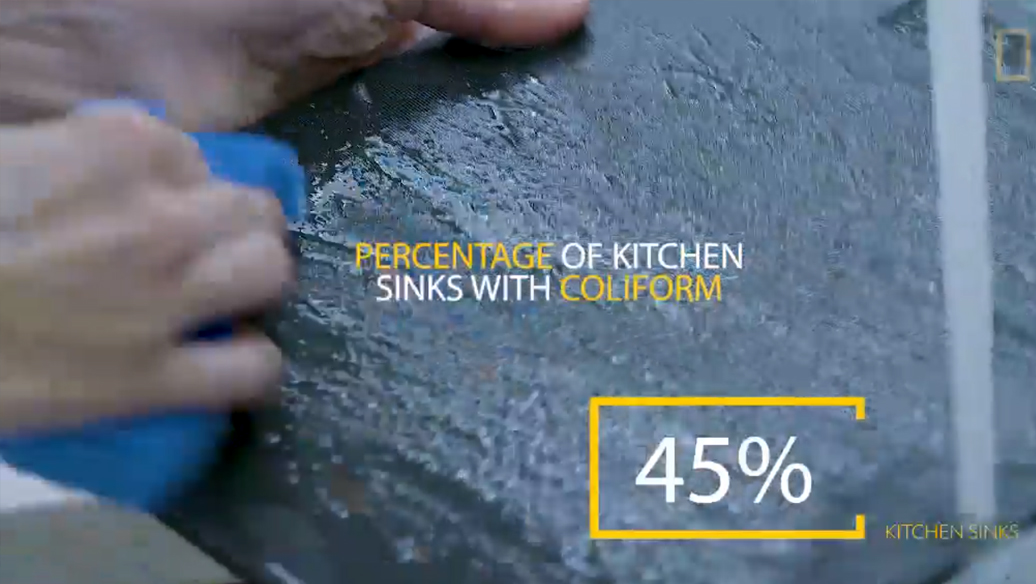[tm_pb_section admin_label=”section”][tm_pb_row admin_label=”Row”][tm_pb_column type=”4_4″][tm_pb_divider admin_label=”Divider” color=”#ffffff” show_divider=”off” height=”50″ height_last_edited=”on|phone” divider_style=”solid”] [/tm_pb_divider][/tm_pb_column][/tm_pb_row][tm_pb_row admin_label=”Row”][tm_pb_column type=”1_2″][tm_pb_text admin_label=”Text” text_orientation=”justified” use_border_color=”off” border_color=”#ffffff” border_style=”solid”]
The average person encounters thousands of different germs every day, but most are harmless.
The germs inside seemingly clean rubber duckies like the ones pictured above can only be seen when they’re sliced open. Here, we look at other common household germ carriers.
“You know how Roman cities were buried over time with debris? Same thing happens to bedding.”
Philip Tierno is describing your mattress. And your pillow. And other soft, squishy surfaces. The New York University pathologist and self-described microbe hunter wrote a book called the The Secret Life of Germs. He knows where they are lurking.
While the average bed might sound like a parthenon of microbial life and pathogens, it’s surprisingly not even the most germ-ridden part of a home, says Tierno.
“Germs are ubiquitous,” he adds. “All living beings, rocks, soil… are riddled with germs. We came from primordial single cells. Germs were here before us.”
They’re on you even now, and on the screen from which you’re reading. Pervasive as they are, the unseen life forms are (usually) nothing to fear. Arming yourself against any potential disease-causing agents requires simply understanding your germy adversary.
What are we talking about?
So what are germs, really? Tiny organisms are everywhere, but the ones considered “germs” includes a number of species of bacteria and viruses. You might also find disease-causing fungi and protozoa in a home, especially in areas that are exposed to humidity.
In the bathroom, for instance, water that comes into contact with a hard surface can create what’s called a biofilm, a slimy film of microorganisms.
In a study published in the journal Biofilms and Microbiomes late last month, researchers dissected rubber ducks—the plastic toys that linger in bathtubs. Inside, they found pathogenic bacteria in 80 percent of the toys they tested.
Surprising as it may be, Tierno says if you’re swabbing for germs in the bathroom, you still haven’t found the germiest place in the home.
“It is cleaner to eat from a toilet, compared to the drain,” he says, referring to the kitchen drain. “The sink drain is the dirtiest area of the house.”
It’s closely followed by the kitchen sponge, he adds.
A 2011 study by NSF International, a consumer safety organization, categorized the household objects with the highest germ count. Only differing slightly from Tierno, they found sponges and dish rags were the dirtiest household items, followed by kitchen sinks, toothbrush holders, pet bowls, coffee reservoirs, bathroom faucet handles, pet toys, countertops, stove knobs, and cutting boards.
[/tm_pb_text][/tm_pb_column][tm_pb_column type=”1_2″][tm_pb_text admin_label=”Text” text_orientation=”center” use_border_color=”off” border_color=”#ffffff” border_style=”solid”]
[/tm_pb_text][tm_pb_text admin_label=”Text” text_orientation=”justified” use_border_color=”off” border_color=”#ffffff” border_style=”solid”]
Where do they come from?
There are three ways that human beings generate germs, says Tierno. The first is the skin. Your biggest organ is a home to hundreds of different kinds of germs, and everyday they slough off.
The second source of germs comes from your respiratory tree—your mouth and nose. Talking, coughing, and sneezing are common ways to impart germs into the air.
The third way humans generate germs is found at the opposite end of the body.
“There are more germs in a single teaspoon of feces than there were men who walked the face of the Earth,” says Tierno.
It’s the germs born here that make the kitchen one of the dirtiest rooms in any given house. Remnants from livestock enter the kitchen on meat, or from the fertilizer used to grow vegetables.
Are they deadly?
“On every pillow in my home, we have a barrier protector. The same with every mattress,” says Tierno. This allergen cover, he says, prevents germs from accumulating over time.
Germs may accumulate easy, he adds, but ridding them from a home simply requires some regular upkeep. Hand washing is also an essential step to keep germs from entering your body.
To really break up the biofilms in a home, Tierno recommends scrubbing surfaces with a metal brush, soap, and water, and a 10 percent bleach solution when it’s really needed. Most people, he adds, have strong enough immune systems to fend off household germs on their own, but as modern medicine allows people with suppressed immune systems to live longer, a greater number of people are more susceptible to the germs around us.
Source: News National Geographic
[/tm_pb_text][/tm_pb_column][/tm_pb_row][tm_pb_row admin_label=”row”][tm_pb_column type=”4_4″][tm_pb_divider admin_label=”Divider” color=”#ffffff” show_divider=”off” height=”20″ height_last_edited=”on|phone” divider_style=”solid”] [/tm_pb_divider][/tm_pb_column][/tm_pb_row][/tm_pb_section]

